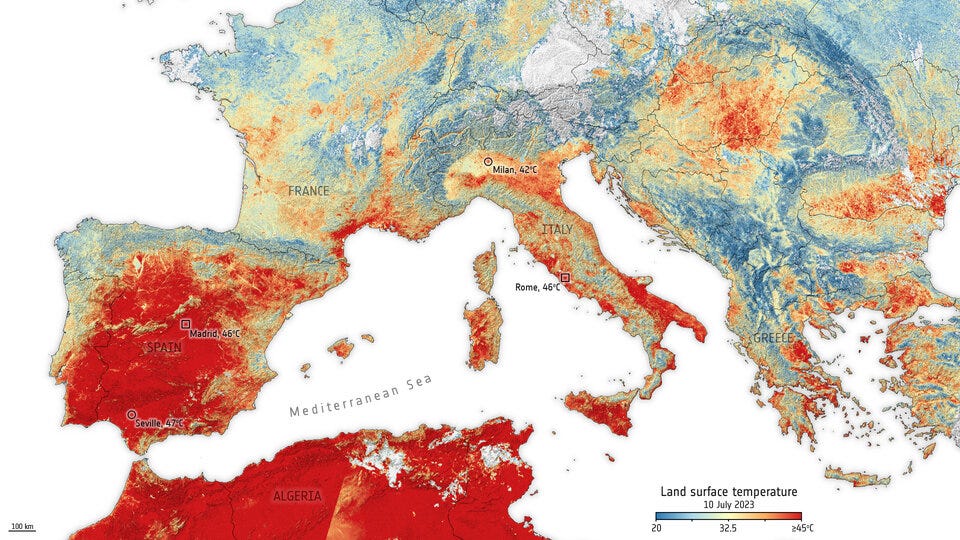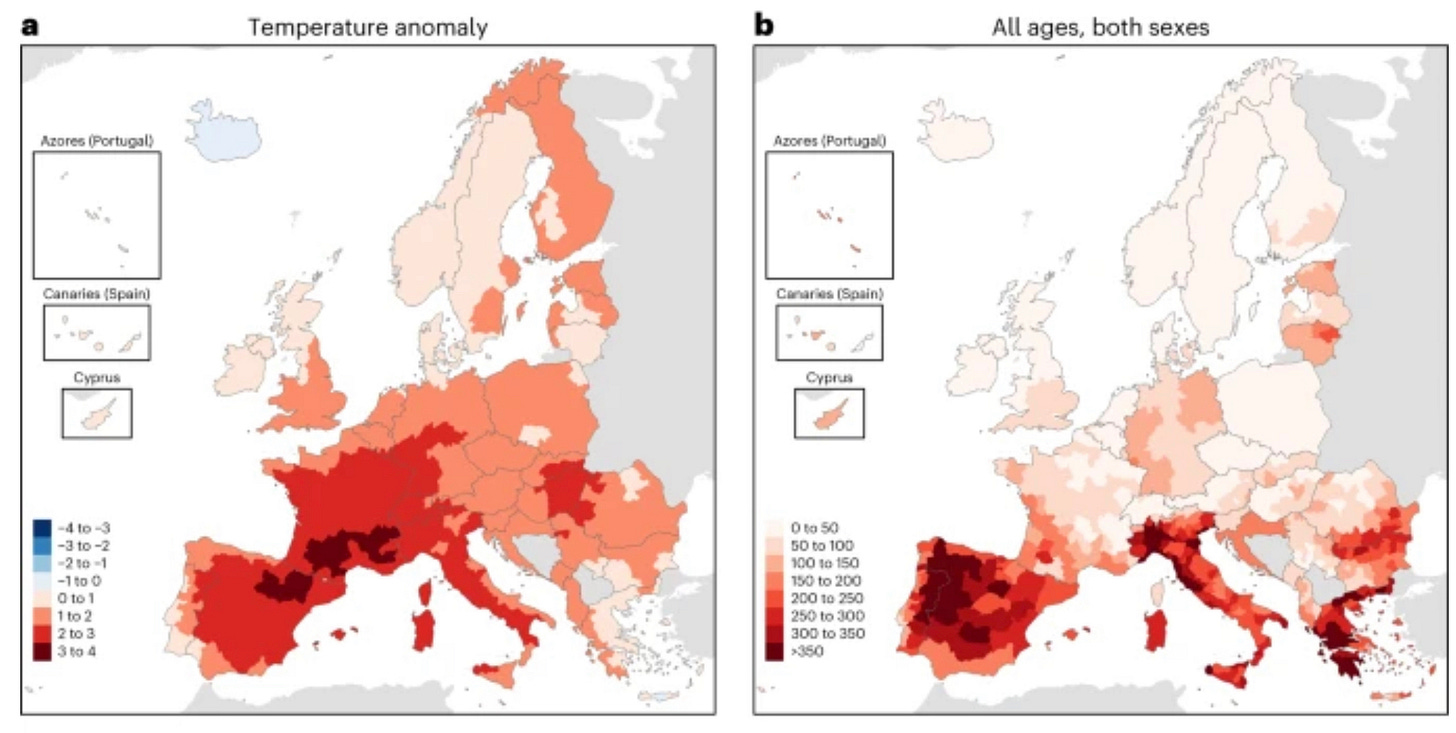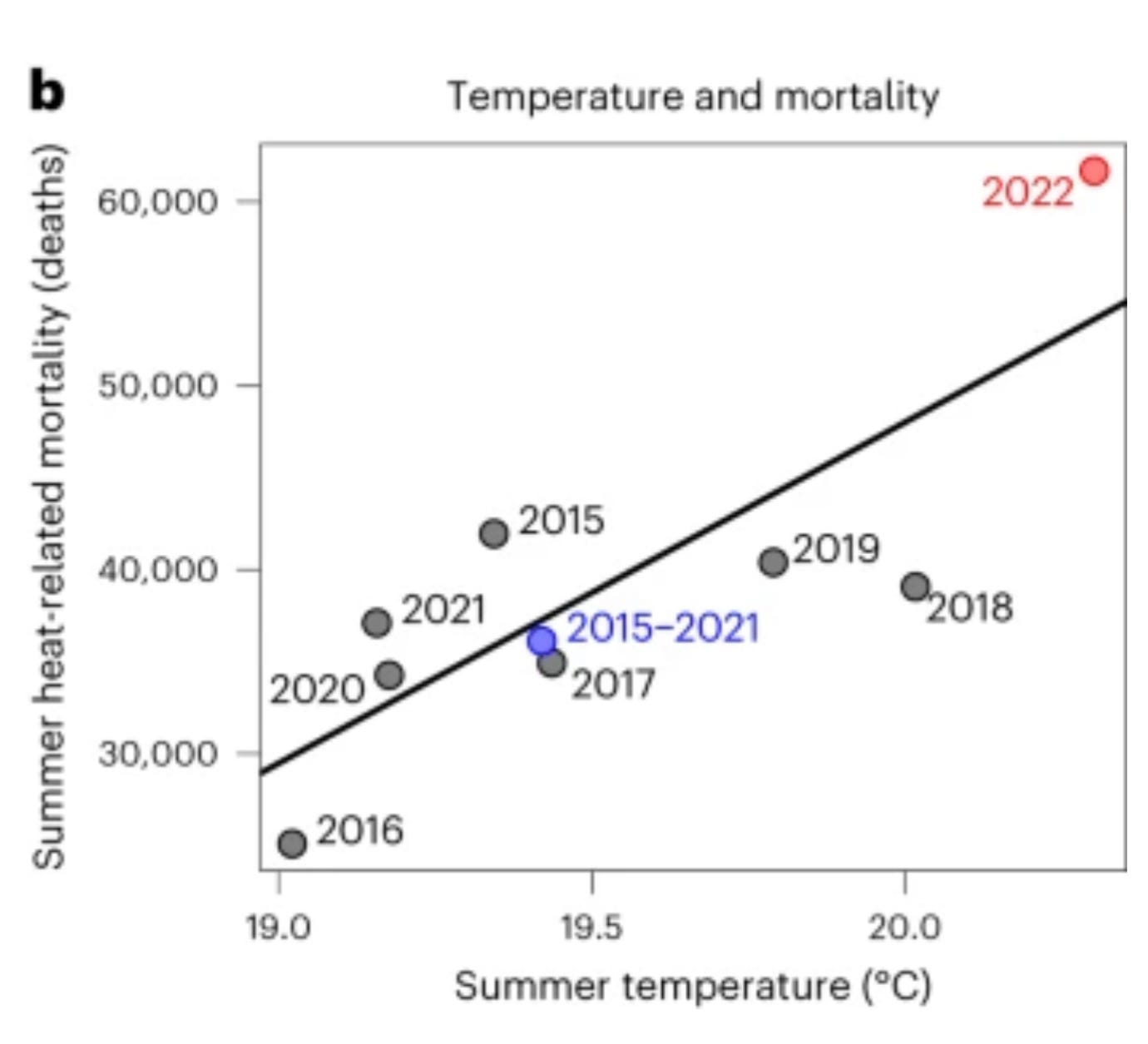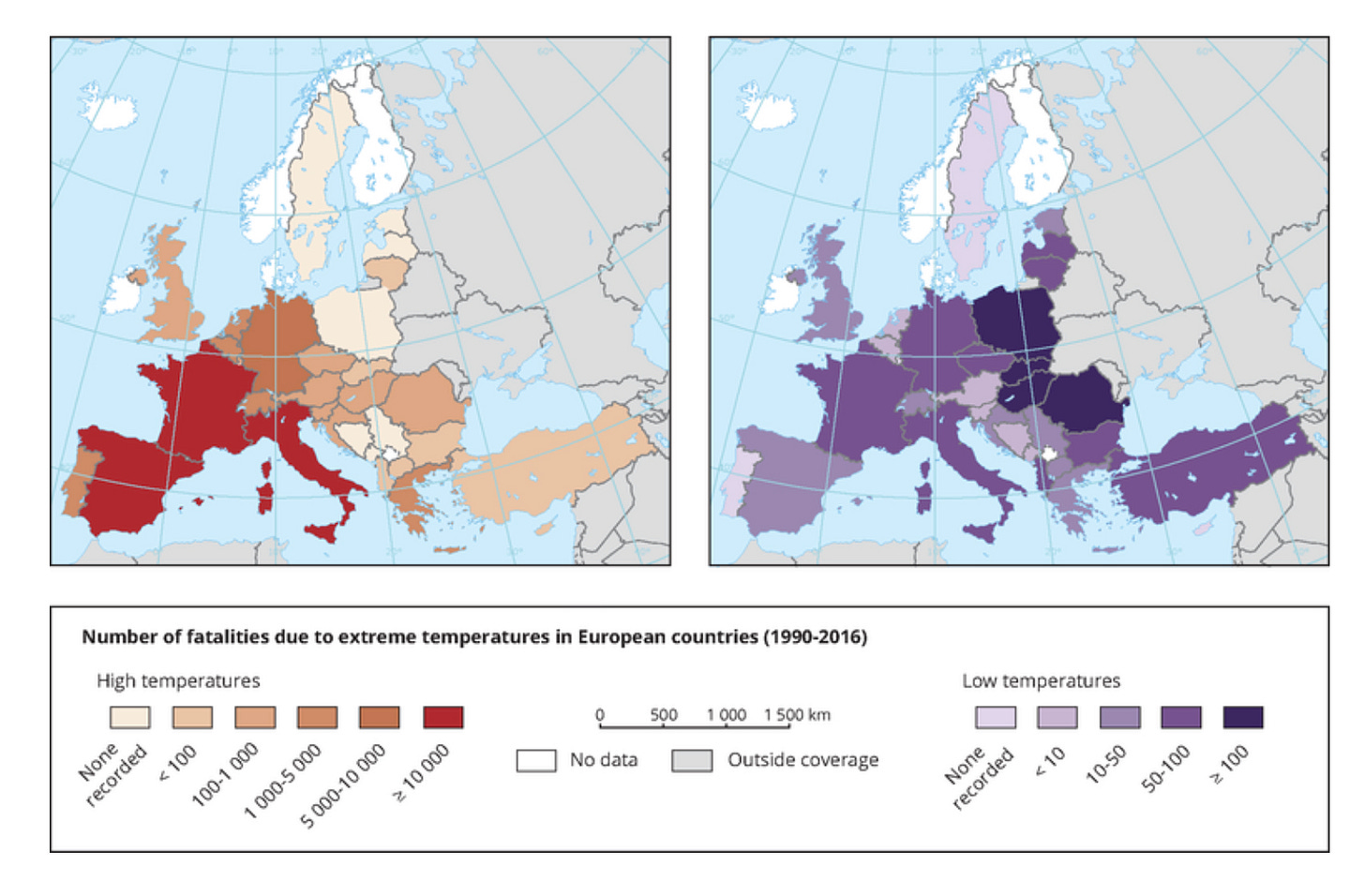18 July 2023. Heat | Music
Heat is a far bigger killer than cold. But there are straightforward responses. // The short road from cutting edge to Top of the Pops. [#479]
Welcome to Just Two Things, which I try to publish three days a week. Some links may also appear on my blog from time to time. Links to the main articles are in cross-heads as well as the story. A reminder that if you don’t see Just Two Things in your inbox, it might have been routed to your spam filter. Comments are open.
1: Heat is a far bigger killer than cold.
Apparently the reasons for the intense heat that we’re experiencing in Europe and the southern USA are fairly straightforward: a combination of climate change effects and the cyclical arrival of El Nino, which always has a warming effect.
All the same, the hear map images are still spectacular: here’s a few of Europe published in the last week by the European Space Agency (disclosure: a client). I could have done without the word ‘sizzling’ in the first line—the ESA publications department could do with reading the climate change reporting guidelines published by Covering Climate Now, which I mentioned here a few weeks ago.
But the meat of the story is a bit more sombre:
An anticyclone – a high-pressure area – named Cerberus (named after the monster from Dante’s Inferno) coming from the south will cause temperatures to rise above 40°C across much of Italy. This comes after a spring and early summer full of storms and floods. The highest temperature in European history was broken on 11 August 2021, when a temperature of 48.8°C was recorded in Floridia, an Italian town in the Sicilian province of Syracuse.
And not just in Italy, as one of the images from the ESA’s Copernicus-Sentinel 3 mission show.
(Source: European Space Agency)
The bright red areas are, basically, 40 degrees and above—wet bulb heat which is dangerous for humans. Unlike weather projections, Copernicus-Sentinel is capturing actual land temperatures—on 10th July, in the image above. The temperatures in Europe follow record-breaking temperatures globally. The World Meterological Organisation pointed out that last week was the hottest on record in earth, and while data from particular days or weeks isn’t that helpful here, the trend is only going in one direction.
The ESA news release pointed to a study published in Nature that assessed the impact of the extreme heat in Europe in 2022 on mortality levels. The researchers calculated that there were more than 60,000 excess deaths because of heat effects.
Here’s a pair of the images from that report: the left-hand side shows heat anomalies, the right hand side shows excess mortality effects.
(Source: Ballester et al, Nature Medicine, 2023)
And here’s another chart from the same study that shows the correlation between temperature and excess mortality over time. 2022 is almost off the scale.
(Source: Ballester et al, Nature Medicine, 2023)
The Discussion section of the paper notes:
This study included an analysis of heat-related risks and mortality numbers according to sex and age groups, showing generally higher values in women and, as expected, steeply increased with age. We showed that age composition was a driver of between-sex and between-country differences; this could closely relate to policy questions around how to efficiently protect the population from summer heat.
I’m going to come back to that briefly lower down, but one of the other pieces here is the difference between summer heat effects and winter cold effects on mortality. To put it bluntly, it’s not even close. Heat is a far bigger killer.
This is a slightly older article, from the European Environment Agency, that compares the effects of hot and cold weather on mortality across European countries between 1990 and 2016.
(Source: The European Environment Agency)
To spell it out: the scale on the left, which measures heat effects, runs from zero to 10,000+, while the scale on the right, which measures cold weather effects, runs from zero to 100+.
An article in BBC Futures talks about some of the things that cities can do to manage this. The article also uses images from the European Space Agency, showing heat effects at a city and district level:
(T)hese heat maps will be increasingly more important in cooling down cities, says Marta Olazabal, head of the adaptation research group at the Basque Centre for Climate Change in Spain. "These maps are extremely useful to diagnose the location of specific urban spaces that are highly exposed to heat," she says, adding that it is "essential" to combine the information with data on vulnerable populations and infrastructure – a method that Austin, Texas, is already using.
—
(A heat map taken during a heatwave in Prague. Water and trees make a big difference. Source: European Space Agency.)
Some of the mitigation effects are surprisingly simple:
Paris, where citizens have the highest risk of heat-related deaths in Europe, has created an interlinked network of "cool islands" where Parisians can seek refuge – from parks and forests to swimming pools and museums. These islands are linked by naturally cool tree-covered walkways and can be accessed via a mapping app called Extrema, which the city developed in 2019... In Seville in Spain, the first city to start naming its heatwaves, the mayor has ordered the installation of more awnings across the city as part of a "policy of shade ", as well as planting 5,000 trees a year and building more public fountains. City officials in Rotterdam, Netherlands, are hoping to plant green vegetation on more than 900,000 square metres (9.6 million sq ft) of rooftops, a tactic which helps cool cities down.
If it is hard to plant trees, painting road surfaces and roofs white, so they reflect heat rather than absorb it, can be surprisingly effective. Athens, and other cities, already have a ‘Chief Heat Officer’. As Marta Olazabal told the BBC Futures journalist, Lucy Sherriff:
"I cannot imagine a future where heat monitoring and planning is not one of the most relevant policy areas in any city worldwide," says Olazabal. "The climate emergency in cities has already become a health emergency and appropriate resources and planning needs to be put in place, without any delay."
2: The short road from cutting edge to Top of the Pops
This is the second part of my post on the rise of British electronic music as a small case study in cultural change. Part One, on Saturday, argued that cultural change went through four stages: first cracks appeared, then those cracks would expand, then the system would recover, and then it would adapt. Today: recovery and adaptation. There is a playlist below.
RECOVER
Just like a rainbow, you know you set me free.
In June 1979, a month after Margaret Thatcher was elected Prime Minister, as if from nowhere, Gary Numan and Tubeway Army were Number 1 with a song called “Are ‘Friends’ Electric?” Numan had chanced upon a synthesiser in a studio where he was recording with his then-punk band Tubeway Army. He had read Philip K. Dick and J.G.Ballard and written stories about a future London.
He incorporated passages from these into his songs. “Are ‘Friends‘ Electric,” whose long spoken passages contribute to the song's strangeness, is about humanoid robots that deliver personal services to the home. As he put it in an interview much later, “I had a No 1 single with a song about a robot prostitute and no one knew.” Other top ten electro hits followed from other groups.
Nonetheless, the electro bands were largely ignored by the record industry majors. This helped the development of electronic music, because it meant that the labels that picked up the bands were fans, such as Tony Wilson of Factory, Rough Trade, and Daniel Miller, both a performer and producer, who created his Mute label for his own work and started releasing the music other bands sent him. This made the community more robust.
Miller signed Depeche Mode to Mute after seeing them perform, their four synths creating a bright poppy sound. When he went to see them, he noticed "their fans weren't watching the band, they were just dancing." Miller's judgement was correct, because Depeche Mode would be all over the pop charts in the 1980s, but the music press hated them. As one member of the band observed,
“We’d do interviews with rock journalists and we’d have a big argument because they didn’t consider electronic music to be proper music.”
Miller's view is that electronic music didn't fit into the music papers’ received idea of a band: “There’s something very un-British about electronic music. They wanted bands to be like they were in the 60s, four guys, guitar, bass and drums, pretty lead singer, skinny jeans, and that’s really what sells newspapers.”
But the music was also riding the wave of change. The electronic pioneers were mostly from working class backgrounds, but their music became the soundtrack for the "loads of money" culture ushered in by Thatcher's election. Heaven 17, their name taken from an imaginary group in Anthony Burgess’ book A Clockwork Orange, tried to parody the culture by presenting themselves not as a group, but as a business enterprise, the British Electric Foundation, but this piece of conceptual art was not read by the audience with the same ironic intent. As Martyn Ware says in Synth Britannia,
“It got taken on board by the aspirational yuppie culture of the early 80s as their theme tune. They completely missed the point of the song.”
Some electronic bands identified themselves more explicitly with the opposition to Thatcherite policies. Cabaret Voltaire had a political intent when they called their 1981 record Red Mecca. Richard H. Kirk says that the insurrection on the streets found its way into their music:
“You took some heart from the fact that people were kicking back against the system, and were willing to take on the police.”
ADAPT
Everybody needs love and adventure,
Everybody needs cash to spend
Tony Wilson, the owner of Factory Records, had told Andy McCluskey that his sound was the future of pop. Wilson was often ahead of his time, but McCluskey was horrified:
“We said, ‘Pop? We’re experimental, German-influenced, we’re not pop at all.’ We couldn’t see it.”
But by the mid-1980s, a combination of further technology advances (such as samplers and emulators) and further experimentation had dragged synth pop into the mainstream. The second wave sounded more like electronic soul. The Human League added two teenage women singers spotted in a club in Sheffield as they recorded Dare, which sold five million copies. A succession of duos combined “fire and ice,” a synth sound with a warm singer: Yazoo, the Eurythmics, Soft Cell, the Pet Shop Boys.
In their different ways all of these groups sounded more familiar to the mainstream while preserving the sensibilities of the earlier experimentation. The Eurythmics maintained the DIY attitude by recording “Sweet Dreams” in the basement. As Midge Ure of Ultravox observed, “It was the first time ever that someone could make a record on their own.” Depeche Mode, mocked as teenypop performers, made Construction Time Again, built around sampling the sounds of ‘80s London’s construction boom.
Similarly, in their first single, ‘West End Girls’, Neil Tennant and Chris Lowe of the Pet Shop Boys looked to reflect the sound of the city, in the same way that Throbbing Gristle had done, but so you could dance to it. Tennant said:
“The idea was to take real life sounds and make it danceable. We were the last of the line that started with the Human League.”
What happened next, of course, was the return of rock, while electronic music became the sound of the dancefloor (think of ‘Blue Monday’, which I wrote about on Just Two Things.). In the documentary, Andy McCluskey says, ruefully,
“Towards the end of the ‘80s, and even worse in the mid-90s, everybody decides that guitars are back in and synthesisers are old-fashioned, and you get Oasis.”
And of course, there’s a passage in the lcd soundsystem song ‘Losing My Edge’ which pretty much just picks up that quote and adds it to the lyric.
If this future seems distant to us now, it’s because, in the 21st century, electronic music is everywhere. It is hard to imagine what the world sounded like without it. It is possible, if difficult, to imagine a world in which producing electronic music was a struggle, culturally and technically. But it is all but impossible to understand what other people’s images of the future meant to them, because, with hindsight, as the future slides through the present into the past, we know what happened next.
j2t#479
If you are enjoying Just Two Things, please do send it on to a friend or colleague.








